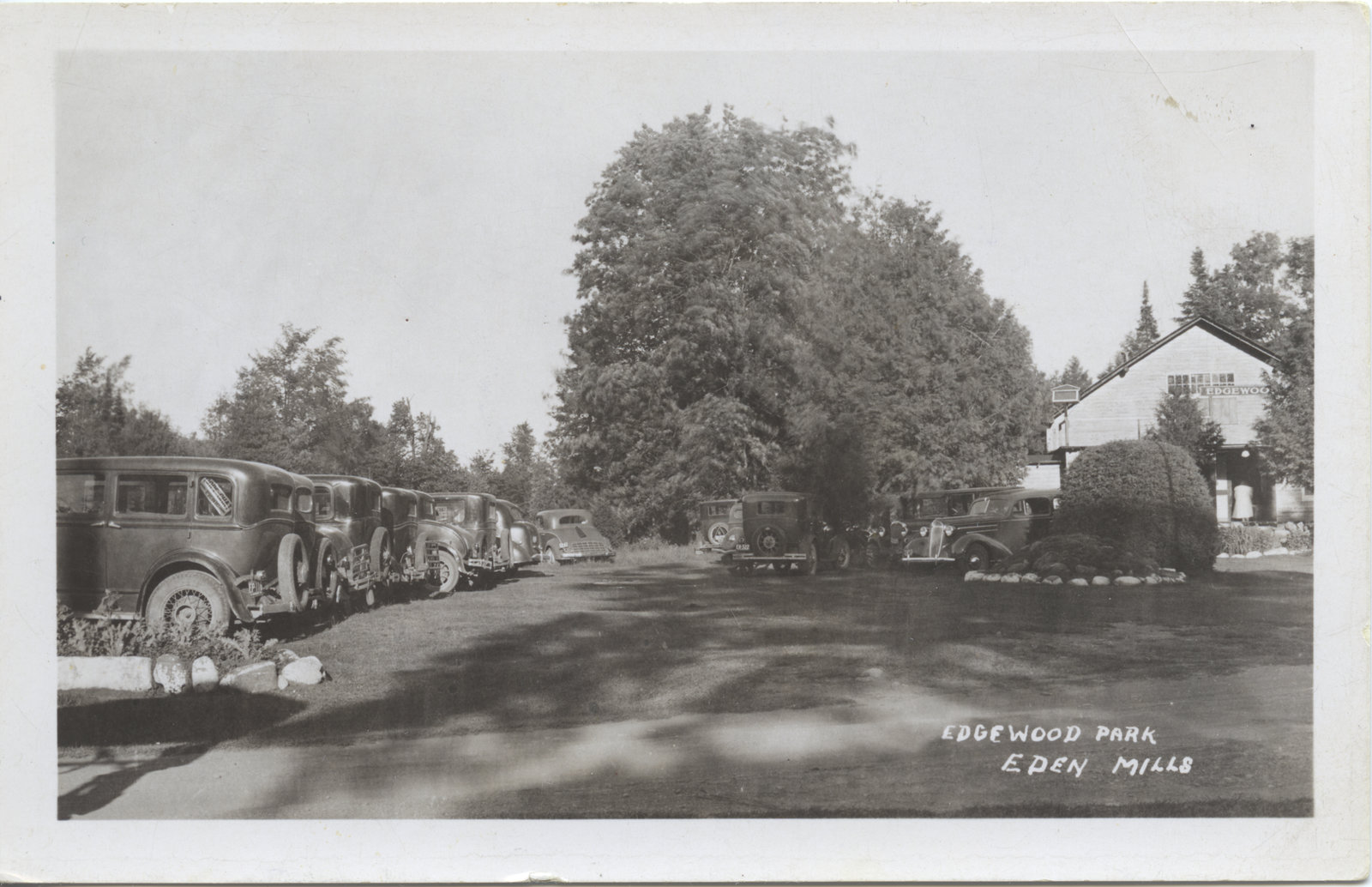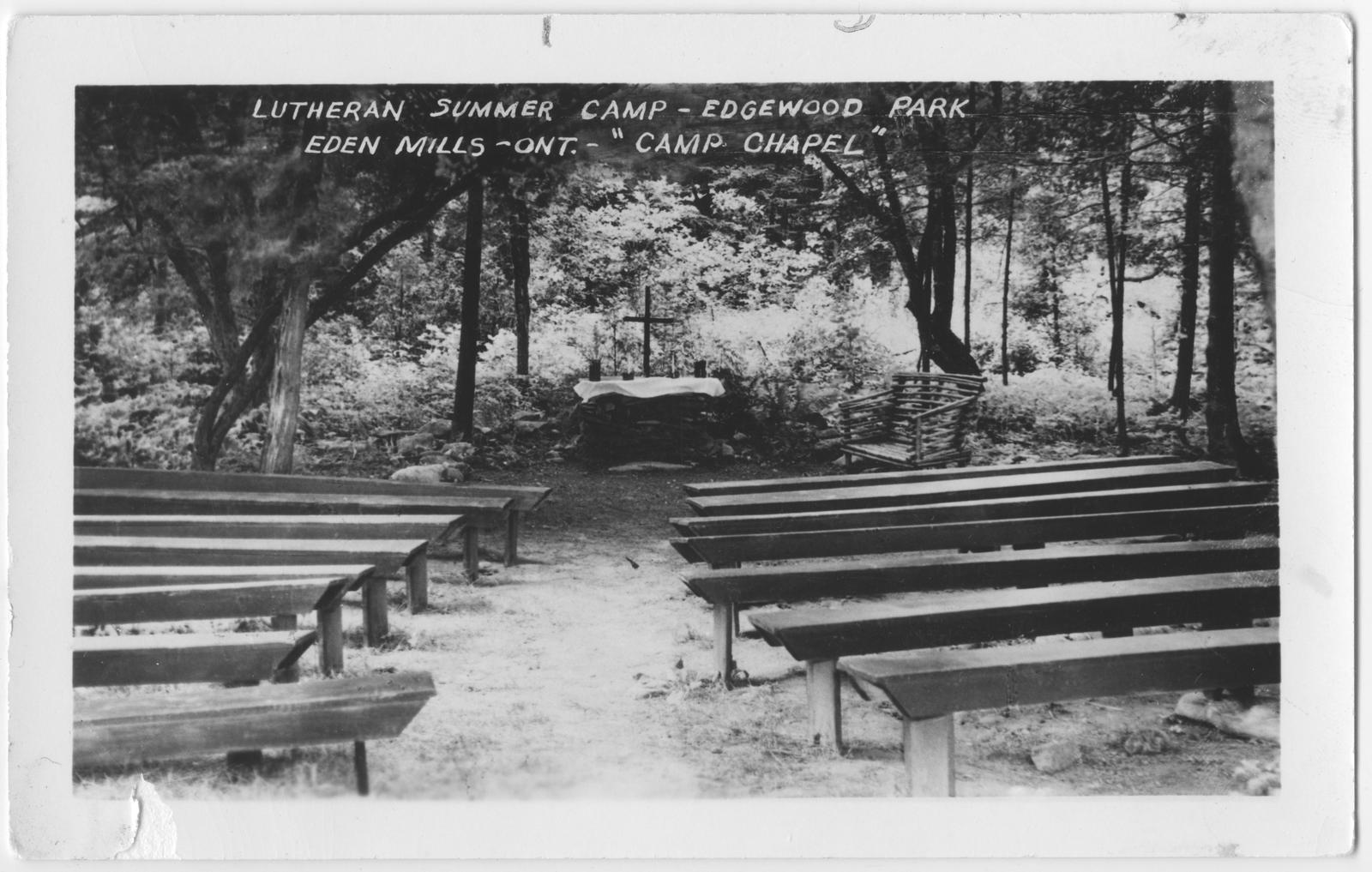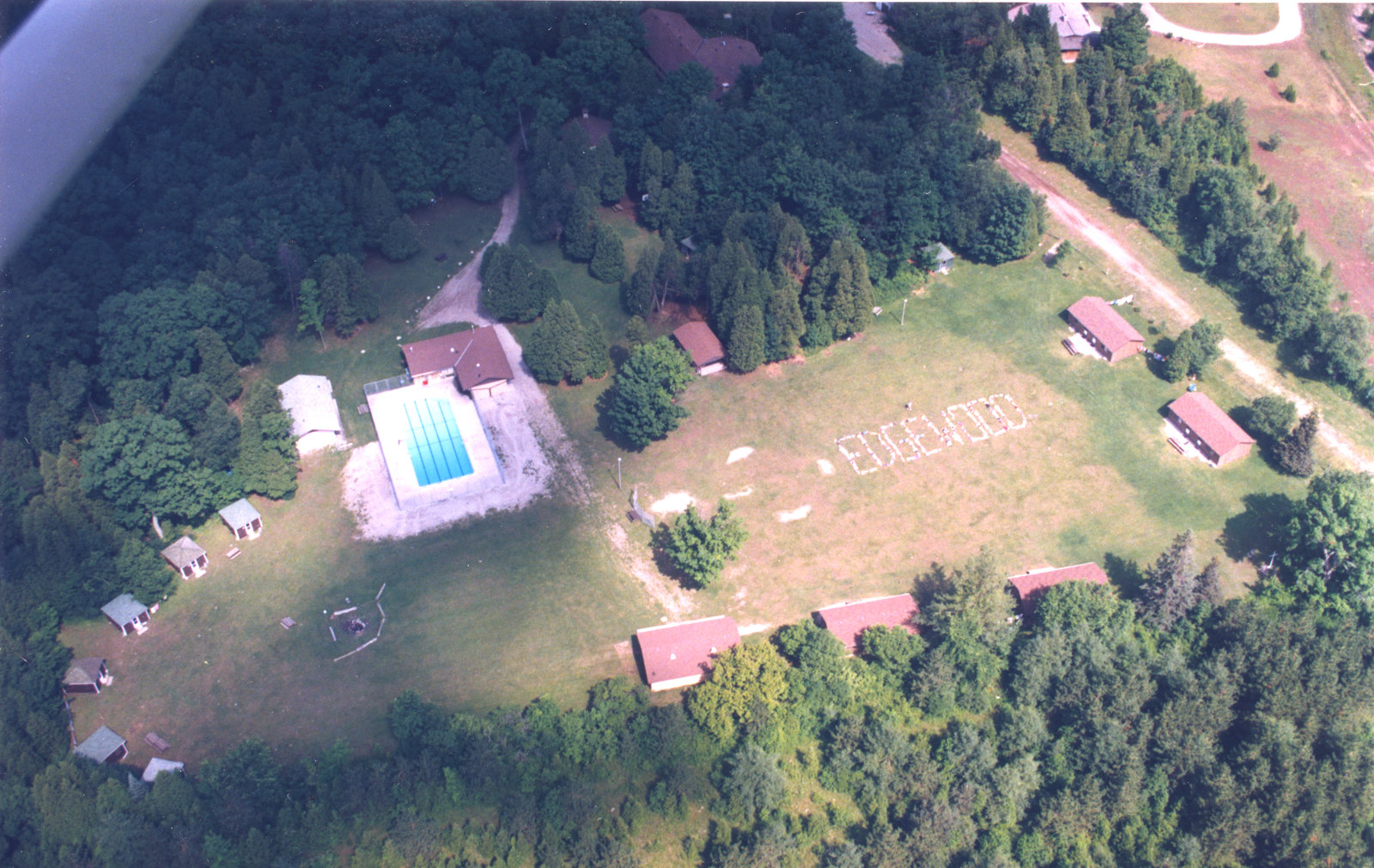In a previous post, I noted that Eden Mills was known early on mostly as a rural village featuring several mills and a modest hotel. However, things had recently changed and the village had become something of a regional destination. At least, it now sported a popular park and summer homes for out-of-towners.
The history of Edgewood Park really begins with the arrival of the Toronto Suburban Railway (TSR) in the village in 1917. Bypassed earlier by the Grand Trunk and the Guelph Junction Railways, the inclusion of a TSR station at Eden Mills promised to lower shipping costs for the produce of the village's mills and the region's farmers.
Of course, the TSR could also bring passengers into town. This meant that people from nearby towns like Guelph, Acton, and Georgetown could easily make day trips to Eden Mills, as could anyone from Toronto who might desire to do so. The commercial potential of this connection was not lost on towns along the route. For example, a fun facility called El Dorado Park was set up at a TSR stop in what is now Brampton. A Ferris Wheel, a Merry-go-round, and other attractions were added to entice daytrippers to buy tickets on the railway.
In 1924 or perhaps early 1925, a group of Eden Mills residents led by Duncan McDougall got together and built a park next to the Eden Mills station. Land was cleared, a picnic area and baseball diamond laid out, and cottages built. In addition, a dance hall was constructed, where acts from Toronto and beyond could drop in by rail and perform for the delight of locals and courting couples.
One of my favourite early ads for the dance venue featured George Wade and his "Corn Huskers", featuring Sid Jackson, the piano accordian expert (Acton Free Press, 18 July 1929):
McDougall added a swimming pool in 1928. Children simply could have swum in the Eramosa river, but a swimming pool was more family friendly. As explained in my post on Riverside Park in Guelph, parks promoted co-ed swimming by building special swimming facilities where boys could be prevented from swimming au natural, as was their wont.Schools and social groups soon began to hold picnics at Edgewood. The Acton Free Press of 10 September 1924 mentions that, "The Union Sunday School pic-nic was held at Edgewood Park on Monday afternoon, an enjoyable time being spent."
The venue also became an annual host to Labor Day festivities. This holiday was established in Canada in 1894 as part of the movement to celebrate industrial labour and provide workers with more time off the job. The 1925 Labor Day celebration at Edgewood Park as quite a shindig:
The celebration here on Labor Day was a fine success and well attended considering the threatening weather that prevailed. The affair was started off with a Calithumpian parade, headed by Acton Citizens’ Band from the village to Edgewood Park. The hard time prize outfits were won by W. Mino and R. Argo and E. Reid. The first ball game was between Arkell and Eden Mills, and was won by Arkell, and in the second game York Road won from Brookville. The third game was won by the picked team against the W.S. Progress Lodge, of Guelph.Not to mention the numerous races and horseshoe throwing contest!
Perhaps the most memorable blowouts at Edgewood Park were the company picnics. The Acton Free Press (6 January 1971) makes special note of the Beardmore & Co. picnics. Beardmore & Co. were a leather tannery in Acton, said to be the largest in the British Empire around 1900. Ontarians of a certain vintage will associate Acton with the Olde Hide House, a large leather goods store and a successor to Beardmore, which made it "worth the drive to Acton."
("The Beardmore Tanneries, Acton, Ont," ca. 1910. Postcard courtesy of the Toronto Public Library, PCR-6.)The 1938 event, held on July 28, was attended by about 500 company employees, their families, and well-wishers. All the usual picnic pleasers were held, including swimming and races for the children, an egg race for the ladies, a fat man's race, and a performance by the Acton Citizens Band. Naturally, the main event was a copious picnic supper.
A special feature of the 1938 edition was the taking of a panoramic picture of the attendees. This was reproduced in the 1971 newspaper thus:
(If anyone knows where a better copy is available, let me know.)This was not the first panoramic photo taken at Edgewood Park. A photo of the "Nth Erin & Gara. picnic at Edgewood Park, Eden Mills," 1930, is available at a better resolution:
(Courtesy of Wellington County Museum and Archives, A2018.4 ph. 51164.)Look carefully and you may see that a man near the middle of the picture appears to have a teacup upside down on his head. Why, we may never know.
Attendance at the 1938 Beardmore & Co. picnic was made possible by the use of "nearly all the motor vehicle transportation available" in Acton at the time. This note reminds us that the TSR was no longer operating when the picnic took place. The Railway was in financial difficulty since its inception, since it was hard to compete with private automobiles and hefty, government road building programs. In 1931, the TSR ceased operations and its assets were sold off. However, its downfall seems not to have clipped the wings of Edgewood Park, which remained an established place for regional recreation.
Even so, change did come to Edgewood Park. In 1944, the Park was purchased by the Lutheran Church of the Canada Synod as a location for their annual summer youth camps. The Church had run a Lutheran Boys Camp at Fishers Glen on Lake Erie since 1936. (A Girl's camp was started in 1940.) However, the camp had outgrown the facility there and the Church went looking for a larger one, which led it to Edgewood Park. Around 1,000 people attended the official opening service on 30 July!
Camp Edgewood, as it came to be known (later Edgewood Camp and Conference Centre), provided camping facilities for various youth organizations, not to mention adult and family retreats, Luther League and Synodical Brotherhood meetings, and Salvation Army events. For example, the Guelph YMCA held its annual camp there until 1951, when they moved on to Camp Nagiwa.
In so doing, Camp Edgewood became part of a significant cultural phenomenon: The Ontario Summer Camp. As Sharon Wall (2009) explains, summer camps for city children had become increasingly popular destinations for young Canadians, particularly in Ontario, especially after the Great War and picking up pace after World War II.
Some camps emphasized a 'wilderness' ideal, in which children were taught how to 'rough it' by swimming, canoeing, woodcraft, and sleeping under canvas. These sorts of camps were typically private, sited in more northern areas of the province (as far as Temagami), and catered to the scions of well-to-do city dwellers.
So-called 'Fresh Air' camps were sited near the big cities and were operated by charities. Their clientele were typically children of low-income families who otherwise would have no respite from the noxious fumes of Ontario's major urban centres like the Big Smoke. (The Toronto Star's Fresh Air Fund began in 1901 as a charity to help urban children escape their overheated urban slums.)
In between were 'agency' campus run by organizations like the YMCA that catered to the middle-class and so funded their operations mainly through fees. Like Fresh Air camps, they lay near the big cities and featured less a wilderness experience than a chance to escape urban hothouses for rural idylls and what be called nature literacy. Camp Edgewood fell into this category.
An article in the 12 June 1952 Toronto Globe & Mail provides an insight into the sort of expeience that campers at Edgewood would have:
Enjoy bedtime snack of hot dogs, crawl in creek to find crayfishThe "Shoebox memories: Edgewood Park" column of the North Halton Compass (2 July 2004) provides a two-page spread of very interesting pictures spanning Edgewood Park's history, which I will insert below. The pictures run from the earliest on page 8 to the later ones on page 9. Page 8: Page 9: The Edgewood totem pole reminds us that 'Playing Indian' was a common feature of summer camp programming in that era. As the ersatz totem pole suggests, the point was not mainly to provide education about Ontario's indigenous peoples but to allow modern children to indulge in a confabulated 'primitive' play-acting, which was held to be a kind of theraputic relief from the ails of modernity they faced in city living.
By Eldon Stonehouse
Guelph, June 11.—The little red school house was never like this.
Pupils in Guelph have moved out doors for this week to get their lessons under the open sky. So far the idea has been working well, and the pupils, at least, wouldn’t mind if teacher Ron Campbell never took them back under the school house roof.
The children, aged 9 to 13, are camped at Edgewood Lutheran Camp at Eden Mills, a few miles from Guelph. And, while some subject such as arithmetic may be slightly neglected during the week in the open air, other subjects such as art, marine life, birds agriculture and water safety are getting more attention than they have since last September.
Teacher Campbell, who was once a swimming instructor, has 36 young students under his care at the wood-fringed camp. And, while they have been as quiet as they ever were in classroom during the first couple of days, the children are enjoying their lessons more than they did during the first part of the year. (Hot dogs for bedtime snacks have helped.)
The open air schoolhouse is something new for Ontario, although it has been tried in various sections of the United States. So far, the Department of Education is keeping a watchful eye on the camp from Toronto and saying practically nothing. Guelph’s school board hopes that when the department does make its comment, it will be favorable.
The Guelph department launched the idea and put up the first $150. Parents of the Grade 5 children added $1 per day for the period the pupils will spend at the camp. The Home and School Association will pick up what’s left of the cheque after the pupils come back to town.
The children moved into the camp on Monday night, and, after getting accustomed to their new surroundings, were hard at work (hah!) by Tuesday. Monday, of course, was a holiday.
On Tuesday, and each succeeding day, the class was divided into groups, each for a different type of outdoor classroom work. Teacher Campbell took the class in first-aid, and also in water safety at the swimming pool.
Supervisors gave the regular teacher a helping hand with various other types of study. Helen Marr taught art in the dining hall, and Ray Mulford each day took a separate group to a nearby bird sanctuary and on a compass hike through the woods.
The Ontario Lands and Forests Department, although not directly involved, lent a hand too. Representatives just happened to drop into the camp to take the youngsters into the woods and teach them how to identify various trees. This lesson caught on about as fast as any, with the possible exception of Bill Hawley’s historical hikes and marine life studies. He had the children in the near-by creek in the water up to their knees capturing crayfish and underwater creatures for identification.
Keith Barber took another group to near-by farms to let them see what life was like in the rural areas. And, lest there be some need for added physical education, Ernie Berner from the Guelph YMCA was on hand to give the boys and girls some pointers on muscle development.
By the end of the first day at the Lutheran Camp, Ron Campbell had decided the outdoor school was a great idea.
“I wouldn’t mind,” he said, “teaching like this for 10 months of the year.”
Bob Noel, 9-year-old pupil, added his approval. “Gee,” he said, “This is keen.”
But if it rains during the week, it’s back to the books on arithmetic and you know what in the buildings on the camp grounds.
Postcards of Edgewood reveal an interesting dichtomy in its depiction.
The first postcard shows the entrance to Edgewood Park, ca. 1940, featured on page 8 of the Shoebox memories article above:
("Edgewood Park, Eden Mills." Real photo postcard; courtesy of Wifrid Laurier University Archives.)While the picture does not show any people, their presence is revealed by the semi-orderly arrangement of parked cars near the office inside the camp entrance, whose shadow is visible in the lower-left corner.
The postcard below shows the entrance to Camp Edgewood, ca. 1950.
("The Gates, Lutheran Summer Camp, Eden Mills." From the author's collection.)This image omits any suggestion of people and instead determinedly shows the camp's gate firmly closed and its religious orientation displayed. The impression it leaves on the viewer is that of a locale under the decided control of its managers and focussed on its sectarian mission. Wall (2009) points out that one of the main concerns of parents sending their kids to camps was the safety, both physical, spiritual, and otherwise, of the facility and its management. The image above seems designed to assure them Camp Edgewood is a secure place.
Another postcard of similar vintage is designed to leave a similar impression:
("Lutheran Summer Camp—Edgewood Park. Eden Mills, Ont.—'Camp chapel'," ca. 1950. Courtesy of Wilfrid Laurier University Archives.)Again, no people are shown. Instead, the outdoor chapel is featured, with its religous symbols and orderly rows of seating. Though rustic, the impression remains one of order and security.
A futher card in the series shows one of the natural attractions of the Camp:
("Lutheran Summer Camp—Edgewood Park. Eden Mills, Ont.—'Camp stream'," ca. 1950. Courtesy of Wellington County Museum and Archives, A2015.1.3, ph. 45682.)This card was sent to Mrs. Dundas, Waterloo, Ont. on 7 August 1951, from Betty, who reports
I am having a very nice holiday and I am hoping you are too.
A final view from the same series shows the scene inside the entrance of Camp Edgewood:
("Lutheran Summer Camp—Edgewood Park. Eden Mills, Ont.—'Inside of camp entrance'," ca. 1950. From the author's collection.)As expected, no one is present but the orderliness of camp is dipslayed in the form of the prominent flagpole, the carefully trimmed lawn and greenery, and the park office looking out from behind it.
This postcard was actually sent through the mail and is postmarked on 10 July 1951. The message states:
Dear Frank [??]It's good to know that people were having a swell time at the Camp!
Monday evening and still Hanging on. The sun was shining swell to-day. Can’t get Bill to go in swimming. Love to you all
Wes
Camp Edgewood was renovated and continued in operation until 2017. It was sold to the Eden Mills Eramosa River Conservation Association (EMERCA), who are incorporating it, under the name Edgewood Trails, into a naturalized area.
(Aerial photo of Edgewood Camp and Conference Centre, 16 July 1996. Courtesy of Wilfred Laurier University Archives.)Works consulted for this post include:
- Kushner, S. (2023). Cover Essay: Reading Ordinary Photographs. Technology and Culture, 64(1), 1-6.
- Wall, S. (2010). The nurture of nature: Childhood, antimodernism, and Ontario summer camps, 1920-55. UBC Press.












No comments:
Post a Comment